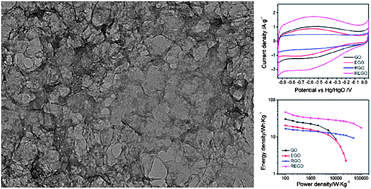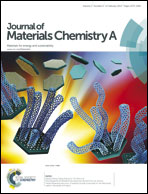Enhanced electrochemical energy storage performance of reduced graphene oxide by incorporating oxygen-rich in-plane pores
Abstract
To effectively enhance the electrochemical energy storage performance of graphene-based materials, oxygen-rich in-plane pores were incorporated into graphene backbones through sonochemical etching of graphene oxide (GO) and sequential chemical reduction treatment. The etching of GO produced a large amount of in-plane nanoscale pores with a high content of oxygen atoms. The hydrazine reduction treatment of etched GO (EGO) resulted in a porous basal plane with good electrical conductivity and preserved electrochemically active oxygen atoms. It is found that good conductivity and in-plane nanoscale pores of reduced EGO (REGO) with enriched electrochemically active oxygen groups synergistically reinforce the electric double-layer capacitance (EDLC) and the pseudocapacitance performance over a wide power density range. Electrodes using REGO demonstrated a maximum energy density of 47 W h kg−1, which is almost three times that of reduced graphene oxide (RGO) without etching treatment, while simultaneously displaying a high power density of up to 100 kW kg−1 with considerable energy density.


 Please wait while we load your content...
Please wait while we load your content...